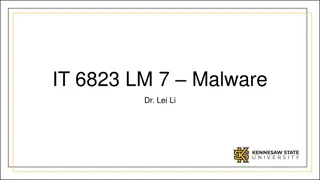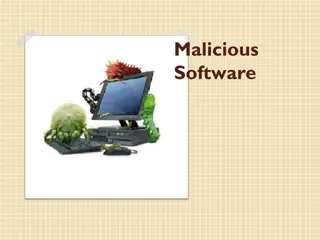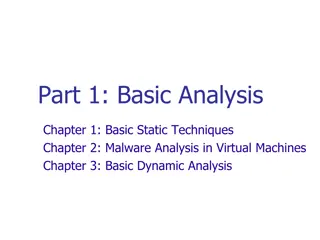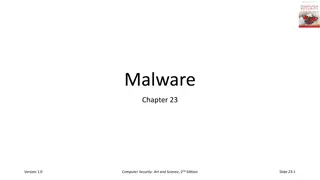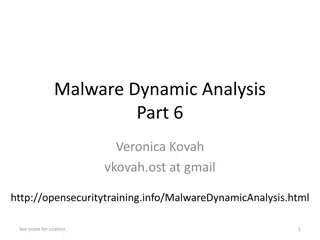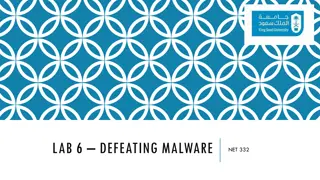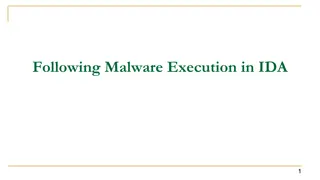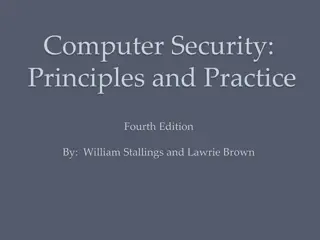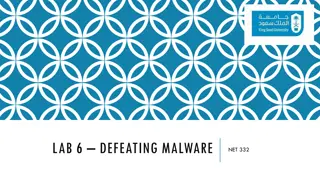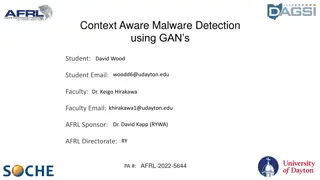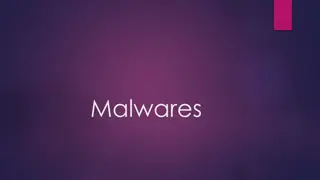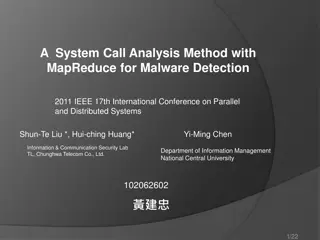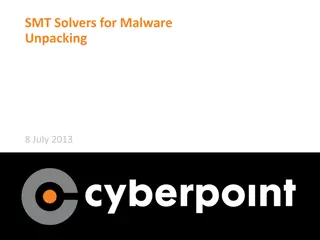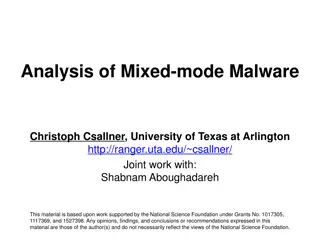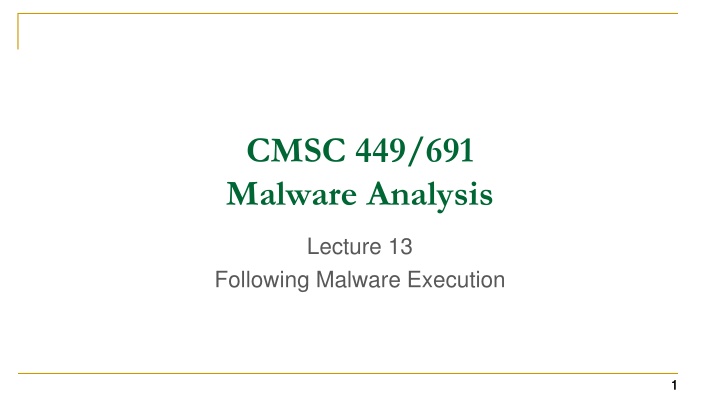
Analyzing Malware Execution, DLLs, and Processes
"Explore the importance of control flow graphs in malware analysis, how malware utilizes DLLs to store code and interact with systems, and the role of processes in managing program execution. Learn about analyzing DLLs, creating processes, and running embedded executables to dissect malware behavior effectively."
Download Presentation

Please find below an Image/Link to download the presentation.
The content on the website is provided AS IS for your information and personal use only. It may not be sold, licensed, or shared on other websites without obtaining consent from the author. If you encounter any issues during the download, it is possible that the publisher has removed the file from their server.
You are allowed to download the files provided on this website for personal or commercial use, subject to the condition that they are used lawfully. All files are the property of their respective owners.
The content on the website is provided AS IS for your information and personal use only. It may not be sold, licensed, or shared on other websites without obtaining consent from the author.
E N D
Presentation Transcript
CMSC 449/691 Malware Analysis Lecture 13 Following Malware Execution 1 1
Following Malware Execution Control flow graphs in IDA/Ghidra are very useful for analyzing the malware s possible execution paths Function calls, loops, if statements, etc. But execution can change in ways other than jumps and calls Often need to find out how the malware is executing different areas of code 2
DLLs 3 3
DLL Review Dynamic Link Library Exports functions for other executables to use Advantage: can be shared among running processes, saving memory 4
How Malware Uses DLLs By storing malicious code May export functions to other malware files May be loaded into another process By using Windows DLLs To interact with the operating system via Windows API functions By using third-party DLLs To interact with other non-Windows programs To use a library that may not be on the victim s machine 5
Analyzing DLLs DLLs have many points where code can be executed from Each exported function DllMain DllMain is called whenever a process loads or unloads the DLL Normally used for managing any resources specific to a process, but malware sometimes uses it for other purposes 6
Processes 7 7
Process Review Process program in execution Used to keep programs from interfering with each other Have separate address spaces OS manages how processes access shared resources (CPU, filesystem, hardware, etc.) 8
Creating a Process The CreateProcess function is typically used to create a process Has many parameters, gives caller a high amount of control over how the process is created 9
Running an Embedded Executable Malware contains an executable as a resource Uses FindResource, LoadResource, CreateFile, etc. to write resource to a file Uses CreateProcess to run this file 10
Creating a Remote Shell Remote shell allows an attacker to run commands on the victim s computer remotely Can create a remote shell by opening a socket and using a single call to CreateProcess! 11
Creating a Remote Shell Need to pass specific arguments to CreateProcess The lpStartupInfo parameter points to a STARTUPINFO struct This struct contains handles to stdin, stdout, and stderr Point stdin, stdout, and stderr to the socket Call CreateProcess to run cmd.exe All input from the malware actor over the socket is run on the command line 12
Creating a Remote Shell Sample Code Practical Malware Analysis pg 148 13
Threads 14 14
Thread Review Thread sequence of instructions belonging to a process that is executed by the CPU Each process contains one or more threads All threads share the process memory space Each thread has its own registers and stack 15
Creating a Thread Done using the CreateThread function Takes lpStartAddress, a pointer to a function Also takes lpParameter, a single parameter to the function The thread executes the function until it returns 16
Stealthy DLL Loading Can use CreateThread to covertly load a library into a process Need to set certain parameters to CreateThread Pass the address of the LoadLibrary Windows API function as the lpStartAddress parameter Pass the name of the desired library as lpParameter Even more stealthy if LoadLibrary and the name of the library are obfuscated 17
Services 18 18
Services Review Service a task that runs in the background without an associated process or thread Managed by the Windows service manager 19
Why Malware Uses Services Can be set to automatically run when the computer boots Gives persistence Often run with SYSTEM privileges But need admin to specify this 20
Creating / Starting a Service OpenSCManager Returns a handle to the service control manager, which is needed for all other service-related API calls CreateService Adds a new service to the service control manager Can specify that the service automatically runs at boot StartService Starts a service manually 21


